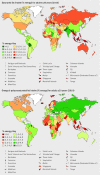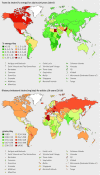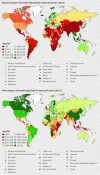Global, regional, and national consumption levels of dietary fats and oils in 1990 and 2010: a systematic analysis including 266 country-specific nutrition surveys
- PMID: 24736206
- PMCID: PMC3987052
- DOI: 10.1136/bmj.g2272
Global, regional, and national consumption levels of dietary fats and oils in 1990 and 2010: a systematic analysis including 266 country-specific nutrition surveys
Erratum in
-
Global, regional, and national consumption levels of dietary fats and oils in 1990 and 2010: a systematic analysis including 266 country-specific nutrition surveys.BMJ. 2015 Mar 26;350:h1702. doi: 10.1136/bmj.h1702. BMJ. 2015. PMID: 25813336 Free PMC article. No abstract available.
Abstract
Objectives: To quantify global consumption of key dietary fats and oils by country, age, and sex in 1990 and 2010.
Design: Data were identified, obtained, and assessed among adults in 16 age- and sex-specific groups from dietary surveys worldwide on saturated, omega 6, seafood omega 3, plant omega 3, and trans fats, and dietary cholesterol. We included 266 surveys in adults (83% nationally representative) comprising 1,630,069 unique individuals, representing 113 of 187 countries and 82% of the global population. A multilevel hierarchical Bayesian model accounted for differences in national and regional levels of missing data, measurement incomparability, study representativeness, and sampling and modelling uncertainty.
Setting and population: Global adult population, by age, sex, country, and time.
Results: In 2010, global saturated fat consumption was 9.4%E (95%UI=9.2 to 9.5); country-specific intakes varied dramatically from 2.3 to 27.5%E; in 75 of 187 countries representing 61.8% of the world's adult population, the mean intake was <10%E. Country-specific omega 6 consumption ranged from 1.2 to 12.5%E (global mean=5.9%E); corresponding range was 0.2 to 6.5%E (1.4%E) for trans fat; 97 to 440 mg/day (228 mg/day) for dietary cholesterol; 5 to 3,886 mg/day (163 mg/day) for seafood omega 3; and <100 to 5,542 mg/day (1,371 mg/day) for plant omega 3. Countries representing 52.4% of the global population had national mean intakes for omega 6 fat ≥ 5%E; corresponding proportions meeting optimal intakes were 0.6% for trans fat (≤ 0.5%E); 87.6% for dietary cholesterol (<300 mg/day); 18.9% for seafood omega 3 fat (≥ 250 mg/day); and 43.9% for plant omega 3 fat (≥ 1,100 mg/day). Trans fat intakes were generally higher at younger ages; and dietary cholesterol and seafood omega 3 fats generally higher at older ages. Intakes were similar by sex. Between 1990 and 2010, global saturated fat, dietary cholesterol, and trans fat intakes remained stable, while omega 6, seafood omega 3, and plant omega 3 fat intakes each increased.
Conclusions: These novel global data on dietary fats and oils identify dramatic diversity across nations and inform policies and priorities for improving global health.
Conflict of interest statement
Competing interests: All authors have completed the ICMJE uniform disclosure form at
Figures





Comment in
-
Nutritional survey data are inaccurate.BMJ. 2014 May 14;348:g3204. doi: 10.1136/bmj.g3204. BMJ. 2014. PMID: 25134123 No abstract available.
-
Lack of evidence that saturated fat causes cardiovascular disease.BMJ. 2014 May 14;348:g3205. doi: 10.1136/bmj.g3205. BMJ. 2014. PMID: 25134124 No abstract available.
-
Authors' reply to Winkler and Ravnskov.BMJ. 2014 May 14;348:g3206. doi: 10.1136/bmj.g3206. BMJ. 2014. PMID: 25134125 No abstract available.
References
-
- World Health Organization. The world health report 1998. Life in the 21st century: a vision for all. WHO, 1998.
-
- Mozaffarian D, Wilson PW, Kannel WB. Beyond established and novel risk factors: lifestyle risk factors for cardiovascular disease. Circulation 2008;117:3031-8. - PubMed
-
- Lim SS, Vos T, Flaxman AD, Danaei G, Shibuya K, Adair-Rohani H, et al. A comparative risk assessment of burden of disease and injury attributable to 67 risk factors and risk factor clusters in 21 regions, 1990-2010: a systematic analysis for the Global Burden of Disease Study 2010. Lancet 2013;380:2224-60. - PMC - PubMed
Publication types
MeSH terms
Substances
Grants and funding
LinkOut - more resources
Full Text Sources
Other Literature Sources
Medical
